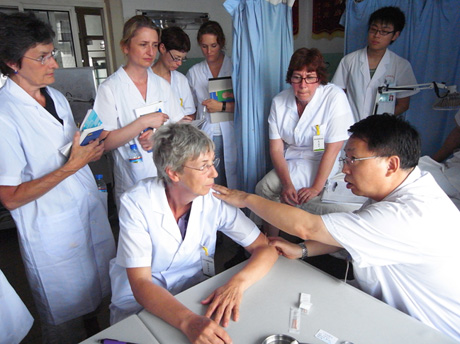US
Slowly but steadily, TCM is traveling across the globe
By Cheng Yingqi (China Daily)
Updated: 2010-08-03 14:06
 |
Large Medium Small |
Rising number of foreign doctors enrolling to learn ancient science
BEIJING - Thirty-one doctors from 14 countries arrived at a university in North China's Shanxi province last week to learn the traditional Chinese way of curing the sick.
The group of foreign doctors began their two-month course at the Shanxi University of Traditional Chinese Medicine (TCM) last Monday.
Since 1998, when the Ministry of Commerce and the health department of Shanxi established the course, some 700 students from 60 countries have undergone TCM training at the university.
"TCM is amazing," the local Taiyuan Daily quoted Dr Amadu John Emmanue, a TCM student from Sierra Leone, a West African country, as saying.
|
 A doctor of traditional Chinese medicine (TCM) at Haici Hospital in Qingdao, Shandong province, instructs students from a medical institute in the Netherlands on the various techniques used in TCM on July 5. Zang Lei / For China Daily
|
"Needle therapy, which we are learning during the two-month course, was a very popular pain-relieving method in my hometown. And it proved more effective than Western medicine," Emmanue said.
Qiao Yunying, who's teaching the 31 students the finer nuances of needle treatment, said most of the students in her class, though already doctors, have never received any sort of training in TCM before.
Besides Shanxi, several foreign doctors also land in Shanghai, Jiangsu, Zhejiang and Guangdong to learn the science of TCM at its place of origin.
| ||||
In 2008 alone, Chinese medical colleges enrolled 10,000 TCM students from abroad, 4 percent of the 223,499 overseas students who came to China that year. Most TCM students came from India, Pakistan and Bangladesh.
TCM started flourishing overseas when needle therapy became fashionable in the United States in the 1970s.
In 1972, the US National Institute of Health, for the first time, sponsored a study on needle treatment. Later, acupuncture anesthesia became an important part of the medical industry, forcing the world to reevaluate TCM.
Nowadays, several million Americans undergo needle treatment every year, and more and more doctors are learning the science, according to media reports.
However, due to the lack of specific laws on TCM in the US, insurance companies refuse to pay for people's medical expenses.
In Australia, where there are 5,000 TCM doctors and 3,000 Chinese medicine drug stores, there is not a single national law on TCM. Only Victoria state issued such laws in 2002.
"Although Chinese traditional treatments are becoming popular outside China, most doctors in Western countries only take them as new methods to cure people besides the existing Western medicine," said Liang Rong, a professor at the Beijing University of Chinese Medicine.
"The world still has a long way to go before it understands the theory of TCM," she said.
In China, TCM is taught in universities as a specialized subject, which is not the case in other countries, she said, adding that the spread of TCM has its limits.
"TCM is medical science based on experiences," Liang said. "An experienced TCM doctor can feel a person's pulse and know what's wrong with him and cure him. It requires a very strong sensibility and the experience of feeling the pulse of thousands of people."
China Daily


